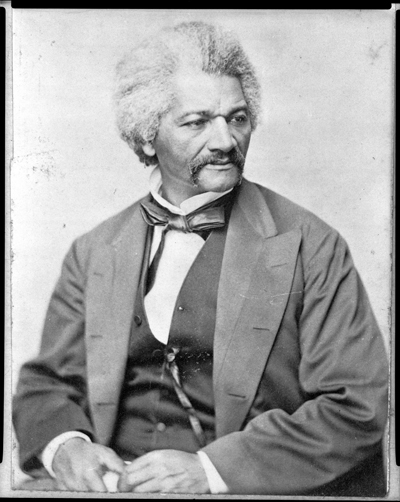Frederick Douglass
Featured Character – 1863
Frederick Douglass was born into slavery under the name Frederick Augustus Washington Bailey. His mother was a black slave and father was white. When young Frederick was nine years old, he was taught to read by his master’s wife, Sophia Auld, until they were stopped by the master, who thought that educating blacks would lead to rebellion. He held many jobs while a slave, but lived well in Baltimore until he was hired out in 1835 to the notorious Edward Covey, the "slavebreaker" who was known for his brutality. Douglass was underfed and beaten until he fought back once and was never touched by Covey again. He attempted escape in 1836, but was caught, jailed, and sent back. On September 3, 1838, disguised as a free black sailor and using another man’s identification papers, he took a train to New York City and his freedom.
He settled in New Bedford, Massachusetts, with his new wife and became a member of a black church, attending abolitionist meetings. He first heard William Lloyd Garrison speak in 1841 and met with him. Impressed by Douglass, Garrison asked him to speak at the Massachusetts Anti-Slavery Society’s annual convention that year. Douglass’ speech about his life in slavery marked the beginning of his abolitionist career. In 1843, Douglass took part in a six-month tour of meeting halls and churches in the American Midwest and along the east coast. In July 1848, Douglass participated in the Seneca Falls Convention attended by many abolitionists and suffragettes. He also began a newspaper called the North Star. In 1863 Douglass met with President Abraham Lincoln to discuss the treatment of black soldiers. He helped convince the president to raise regiments of former slaves and free blacks to help free their brethren in the South.
After the war, he supported Ulysses S. Grant’s presidential
campaign. As commander-in-chief, Grant enforced the Klan Act and the
Enforcement Act, laws to try to protect blacks in the South from
domination and intimidation. Douglass wrote several books. The best
known is his autobiography, Narrative of the Life of
Frederick
Douglass, an American Slave (1845). It became a best seller
in the
1840s, and continues to be widely read. He died at his home in
